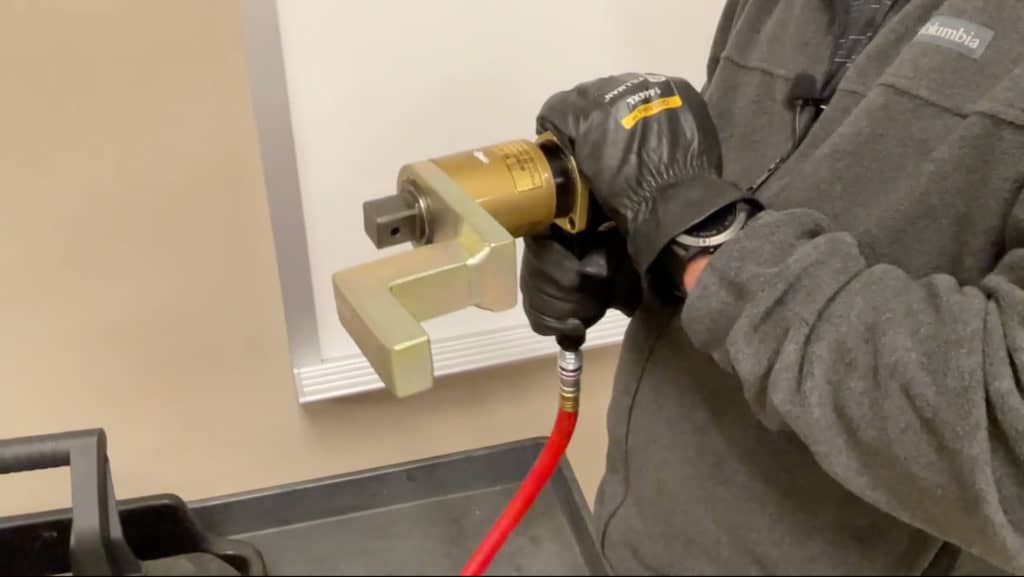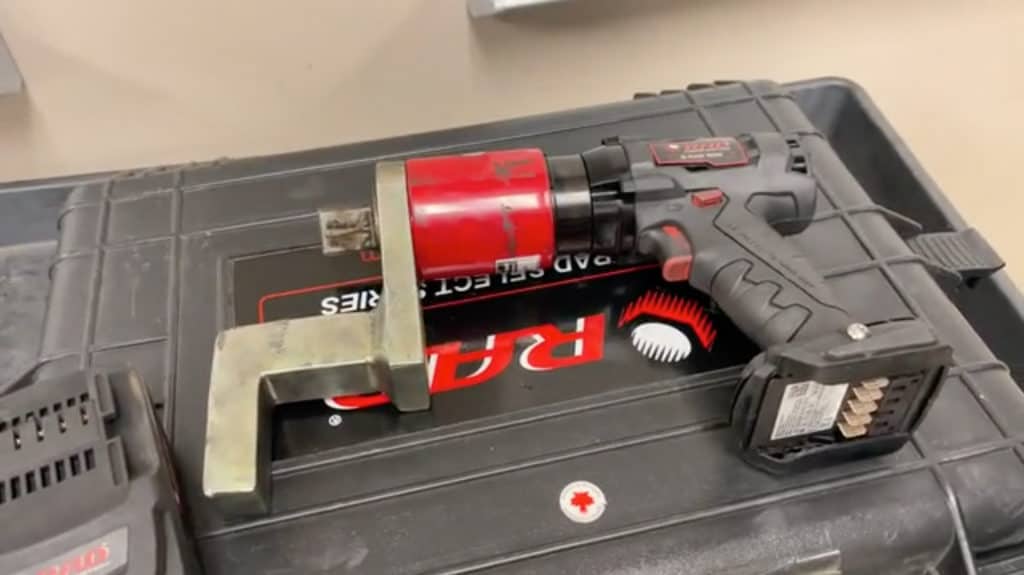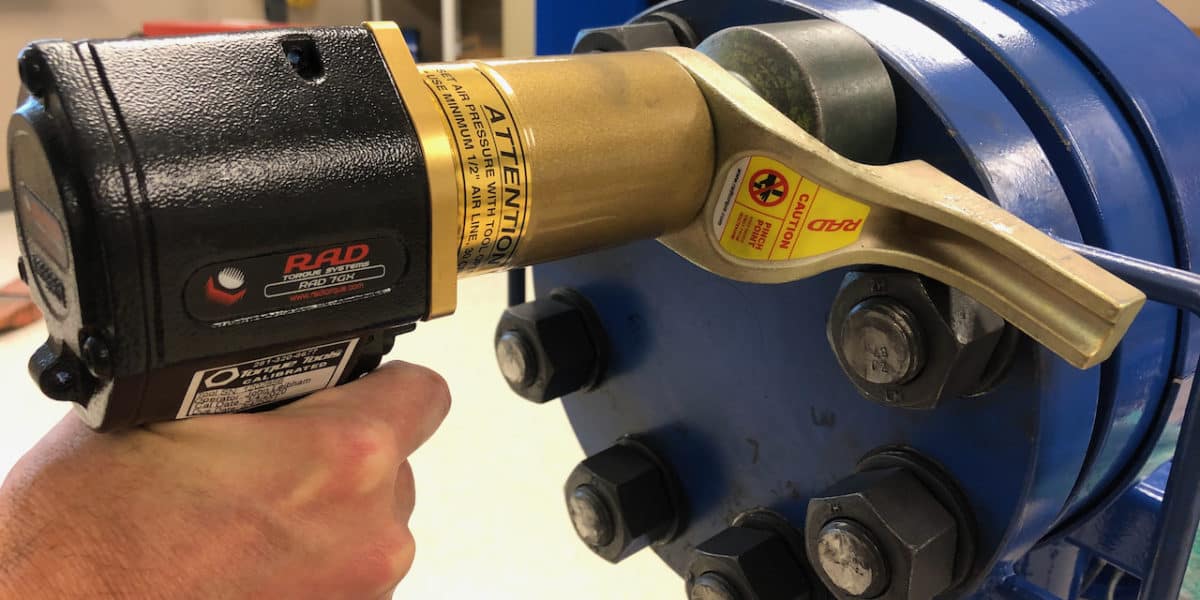Roughly 25 years ago, pneumatic torque wrenches (a.k.a. pneumatic torque gun or pistol grip) torque wrenches were commercialized enough to make them one of the main staples for bolting solutions found in oil & gas or power generation. We have seen the pneumatic torque wrench technology move to both battery and electric powered pistol grip torque wrenches to improve the accuracy and repeatability in bolting applications.
The oil & gas bolting industry has seen an increase in pistol grip tools as they are ergonomic, heavy duty, have an adequate torque range for most fasteners, and have high-speed continuous rotation without having to ratchet. This makes them faster than other controlled torque options (such as hydraulic torque wrenches).
We typically see pistol grip wrenches in heavy duty applications because in order to achieve a high torque output (typically greater than 500 to 600 ft-lbs) on a fastener you should where it is easier on the assembler and you can generate better accuracy and repeatability than with an impact wrench or other unregulated “torque tools.”
Pistol Grip torque wrenches consist of a motor (typically powered by air pressure, battery power, or electricity), a gearbox design (planetary gearbox or gearbox) which acts as a torque multiplier, a square drive, and a standard reaction arm.
- NOTE: These pneumatic tools should not be confused with impact wrenches as impact wrenches do not have an FRL (filter-regulator-lubricator) or another regulated power source (electricity or battery power).
- Since these pistol grip wrenches have a high torque output typically ranging from 50 ft-lbs to 15,000 ft-lbs. Both the min and max torque range is dependent on the capacity and of the square drive size. Each one of these pistol grip torque tools has a calibration certificate specifically for each tool (serial number and not model) that has the readout of the input vs. the torque value (typically found in ft-lbs or Newton-Meters).
NOTE: Hex Technology has had significant experience with pistol grip torque wrenches and suggests contacting us if you have further questions after this article.
NOTE: See our articles on Hydraulic Torque Wrenches and Stud Tensioners for other power tool options to achieve high loads on fasteners.
Pneumatic Pistol Grip Torque Wrenches

The first type of pistol grip torque wrenches that we will discuss is the pneumatic torque wrench. These are powered by air pressure that goes through the air motor, and at the end of the gearbox is a reaction arm that is used to absorb the torque and allows the tool operator to use it with little effort (thus making it ergonomic). These guys are great because they have a very high torque output and they’re normally smaller than an impact wrench as well.
These advantages include being relatively easy to use. If you’ve used an impact wrench, the only difference with a pneumatic torque wrench is that you’ve got to do is dial your torque with the FRL Some of the best reasons to use pneumatic torque wrenches is they have no vibration, operate at less than 80 decibels, are ergonomic, and they have a higher torque output than what impact wrenches do.
NOTE: All pneumatic tools are not the same. An impact wrench does not have accuracy or repeatability while pneumatic torque wrenches do.
Battery-Powered Pistol Grip Torque Wrenches Work

Battery-powered pistol grip tools are more common in the oil & gas industry now than they were 10 years ago, and I project that they’re going to be even more common than pneumatics in the next couple of years because it was just so convenient to use.
Since they are battery-powered, you do not need an air hose or electrical socket! They are typically more accurate and repeatable as they have a digital gauge and not a dial gauge.
Electric Powered Pistol Grip Torque Wrenches
The pistol grip wrench that we’re going to talk about is electronic torque wrenches. We don’t see these a lot in the oil & gas industry because it needs electricity, which means you need a hot work permit. We see them more in the power industry, wind industry or structural steel industry, but you can see right here that it’s got an entire box dedicated to setting the torque value and then there’s an output to the wrench itself. Each manufacturer has got strict calibration requirements for these, so please contact them if you’ve got any questions. Do not go into that box and try to adjust it yourself, as that will be a very expensive mistake.
Pistol Grip Torque Wrench Safety
The first thing we’re going to talk about when using these wrenches is safe use and operation. Pinch points are a common safety hazard around the reaction arm of these tools. The reaction arm swings over and reacts against the next nut or possibly the flange. That is not a handle, do not use it as a handle. Keep your hand as far away from the reaction arm as possible. If the torque wrench is putting out a thousand foot-pounds, that reaction force on the reaction arm is going to be a thousand foot-pounds and you’re going to lose a finger.
It is also important that the user have a solid reaction point. Curved or bad reaction points can cause the tool to bind up and put excess load on the gears within the tool. Multiple reaction arms are available from the manufacturer to achieve proper reaction arm placement if the standard reaction arm is not suitable for your application.
Pistol Grip Torque Wrench Maintenance
When talking about the maintenance of these tools, you have to remember that they are precision instruments and should be treated that way. Don’t just leave them in the back of the truck overnight. Make sure that they are in an environmentally controlled place so that rain doesn’t get on them, water doesn’t get on them when they’re not in use.
Preventative maintenance will give early detection of worn-out tolerance in these tools and prevent premature failure. For pneumatics, one of the things that we like to do is make sure that when you plug the air in on the FRL, there’s a little nozzle on the filter that you can loosen and it spits out all of the water and all of the dirt that you’ve gotten inside of the hose. Also, make sure that your lubricator is filled with air tool oil. You can see one drip every 10 to 15 seconds from the sight glass of the lubricator.
Unfortunately with the electric and the battery-powered, there’s not a lot of preventative maintenance that you can do on these tools as everything is pretty much closed circuit. The one thing I do not want you to do is go in and try to fix that planetary gear set yourself. It is super complicated with hundreds of moving parts, and you’ll probably end up buying a new tool if you do that.
Also if you hear anything not working properly, it’s making a grinding noise, don’t keep pulling the trigger because that’s $500 a piece, and get it to a licensed repair shop to get fixed and recalibrated.
Pistol Grip Torque Wrench Calibration Certificate
Calibration certificates for all of the pistol grip wrenches are pretty much the same, and while there is no industry requirement, the standard is to calibrate these once a year. However, these tools should be load verified throughout that calibration year. Meaning you should put them on a Skidmore (or equivalent) and test their accuracy and repeatability just to make sure that the tool is staying within its calibration certificate‘s torque readout.
Conclusion
In conclusion, pistol grip torque wrenches are absolutely awesome to use in the field as they’re super convenient and are high speed (because they do not have to ratchet) compared with other bolting torque methods. With the battery torque wrench, you don’t have to have a hose, you don’t have to have a box, so they’re really easy for the one off flanges. They will probably break down more frequently than the pneumatics just because the handle is not as robust. However, all these wrenches are great for piping flanges, heat exchangers, manhole covers, and any heavy duty bolting applications found in oil & gas.
All pistol grips are square drive tools, so If you can fit an impact in there, you can fit one of these torque wrenches in there.
Join Industry Leaders!
Subscribe to Hex Technology today and we’ll give you $700 in bolting courses, FREE. Your path to a safer, more reliable, more profitable site starts here.


